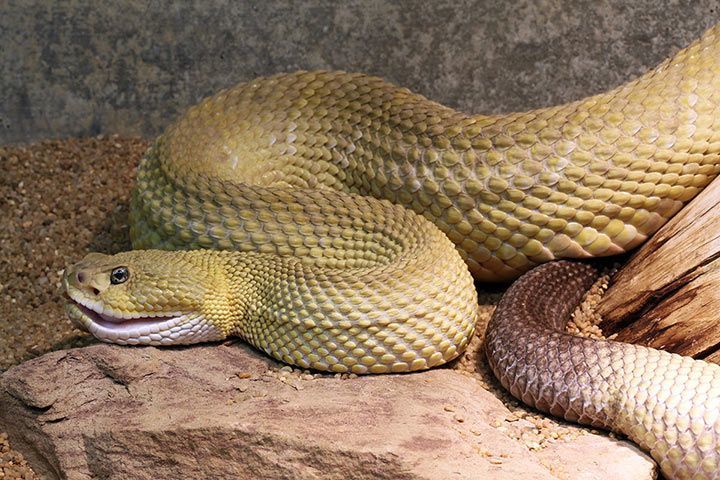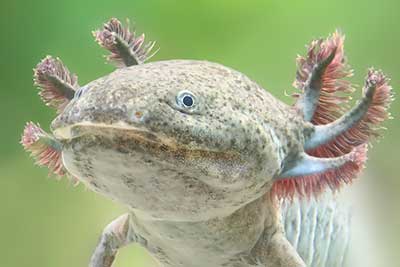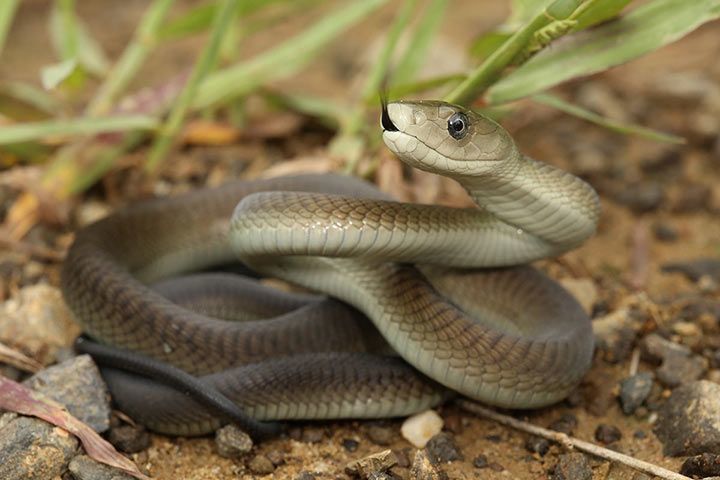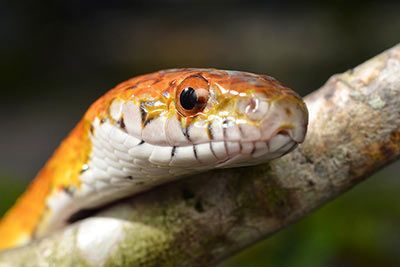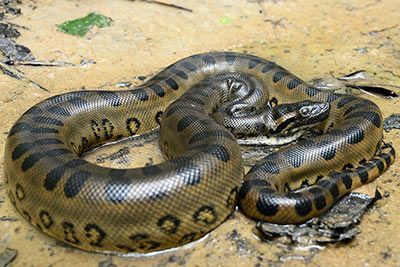Rattlesnake
Rattlesnake Facts
| Size | Up to 7.8 ft (2.4 m) |
| Speed | Unknown |
| Weight | Up to 10 lb (4.5 kg) |
| Lifespan | Up to 30 years (in terrariums) |
| Food | Mice, prairie dogs, rats, rabbits |
| Predators | Foxes, buzzards, coyotes |
| Habitat | America |
| Class | Reptiles |
| Order | Scaled reptiles |
| Family | Vipers |
| Scientific name | Crotalus |
| Characteristics | “Rattle” at the end of the tail |
Main Characteristics
Rattlesnakes are known for the rattle at the end of their tail, which they use to make noise in case of danger. There exist 29 species, which exclusively live on the American continent.
Habitat
Where Do Rattlesnakes Live?
Normally you would expect rattlesnakes to mainly live in the desert. Yet they often can also be found in swamps and are very good swimmers.
Anatomy and Appearance
The Largest Rattlesnake
The biggest rattlesnake is the Eastern diamondback rattlesnake. It can grow up to 7.8 feet (2.4 meters) long and reaches a weight of 10 lb (4.5 kg). The second largest rattlesnake is the Texas diamond back.
The Smallest Rattlesnake
The smallest is the ridge-nosed rattlesnake with a length of about 20 inch (50 cm) and a weight of 3.5 oz (100 g). The smallest of them are only 11.8 inch (30 cm long).
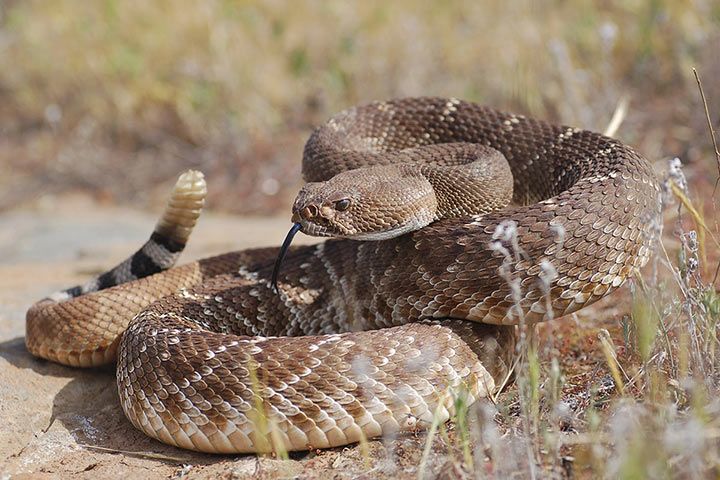
The Rattle
Why Does The Rattlesnake Rattle?
It may sound funny, but the snake primarily uses its rattle to keep hoofed animals away. The rattling noise warns them and prevents them from accidentally treading on the snake.
How Does the Snake Produce the Rattling Noise?
The rattlesnake has very strong muscles and uses them to shake the rattle – if the snake is very excited it can do this 50-60 times per second and for up to three hours. The horrific sound is produced with the rings of the rattle vibrating against one another. By the way: The rings are hollow inside, while toy rattles are mostly filled with little beads.
What Is the Rattle Made of?
The rattle is made of a material that is quite similar to our finger nails and hairs. Whenever the snake sheds its skin, another ring is added to the rattle. It is basically a leftover at the tip of the tail that cannot be shaken off. Yet, it is not possible to use the number of rings to determine the age of the rattlesnake, because they can break off occasionally.

Behavior
How Does a Rattlesnake Find its Prey?
The rattlesnake perceives smells with its tongue. Like all pit vipers, it also has two pits (hence the name of the animal family) at both sides of the head. They contain an organ that functions like a heat sensor. You could also compare it to an infrared or heat-detecting camera. The snake can sense even the slightest fluctuations in temperature with it. A difference of 0.2–0.4 degrees Celsius is enough for the snake to know that there is some prey close by.
The Venom
How Venomous Is the Rattlesnake?
The rattlesnake is one of the most venomous snakes worldwide. Even 0.03 oz (1 g) of its venom is enough to kill 3,000–5,000 mice.
Rattlesnakes Carefully Dose Their Venom
When biting, a rattlesnake is able to determine the exact amount of venom to be used. This makes sense, because it takes a lot of energy to produce the venom. It would be silly to kill a mouse with an enormous amount of venom and then be left without any venom for a larger animal of prey. Young rattlesnakes are generally not as good at controlling the amount of venom – therefore they usually are more dangerous.
Enemies and Threats
Does a Rattlesnake Have Enemies?
Yes, for instance foxes, coyotes and buzzards. There is even one snake species that preys on rattlesnakes: The kingsnake is immune against the venom of the rattlesnake.
Senses and Abilities
Can Rattlesnakes Grow Back Fangs?
If necessary, the rattlesnake can replace its teeth every few weeks. Thus, sometimes it has four teeth at the same time, but only two of them are in use.
Reproduction
Rattlesnakes are grown up after 18–24 months. They mate in spring, but do not lay eggs. Instead they give birth to 10-20 babies after a gestation period of about 90 days. At first they do not have a rattle, which develops when the snake sheds its skin.
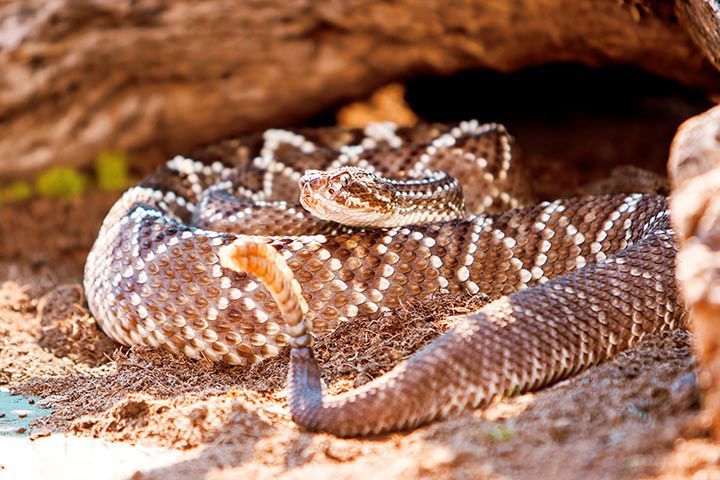
- Find Out More:
- Black Mamba Facts
- Corn Snake Facts
- Green Anaconda Facts
- More About Venomous Animals:
- Venomous Mammals
- Animals That Use Spikes and Spines as Tools
- The Most Poisonous Animals
- Venomous Animals in Germany
- The Most Dangerous Venomous Snakes: Asia
- The Most Dangerous Venomous Snakes: Africa
- The Most Dangerous Venomous Snakes: Australia/New Guinea
- The Most Dangerous Venomous Snakes: Central and South America
